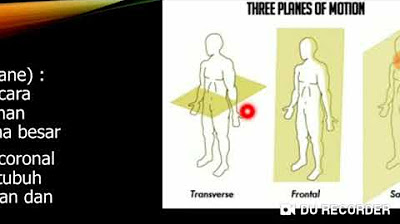ACROMIOCLAVICULAR MOTIONS #SHOULDER BIOMECHANICS
Summary
TLDRThis educational video delves into the complex motions of the acromioclavicular joint, focusing on three key rotatory movements: internal and external rotation, anterior-posterior tilting, and upward and downward rotation. It clarifies that these motions occur in oblique planes due to the scapula's unique orientation. The video simplifies the understanding of these often challenging concepts by breaking down the movements into their axes and planes, and provides the normal range of motion for each. It's a valuable resource for those studying human anatomy and biomechanics.
Takeaways
- 🔄 The acromioclavicular (AC) joint has three types of rotatory motions: internal and external rotation, anterior-posterior tilting, and upward and downward rotation.
- 🧐 Understanding the AC joint's range of motion is challenging due to the wide variations among individuals and the difficulty in studying its particular surface.
- 🤔 The AC joint is a plane synovial joint, characterized by three rotatory and three translatory movements.
- 📏 The three translatory movements of the AC joint include anterior-posterior, superior-inferior, and medial-lateral translations.
- 🤷♂️ The movements in the AC joint do not occur in perfect cardinal planes but in slightly oblique ones, influenced by the scapula's orientation.
- 🏋️♂️ Internal and external rotation of the AC joint occur around a vertical axis in the transverse plane, with the glenoid fossa as the reference point.
- 🔄 Anterior and posterior tilting of the AC joint happens around an oblique x-axis and primarily takes place in the sagittal plane.
- ⬆️⬇️ Upward and downward rotation of the AC joint is around an oblique AP axis, with the movement occurring in the frontal plane.
- 📐 The normal range of motion for internal and external rotation is approximately 30 degrees, for anterior and posterior tilting is about 20 degrees, and for upward and downward rotation is 30 degrees and 40 degrees respectively.
- 💡 The movements of the AC joint are essential for the scapula to maintain its relationship with the curvature of the ribs during shoulder movements.
Q & A
What are the three types of rotatory motions in the acromioclavicular joint?
-The three types of rotatory motions in the acromioclavicular joint are internal and external rotation, anterior-posterior tilting or dipping, and upward and downward rotation.
Why are acromioclavicular joint motions considered difficult to understand?
-Acromioclavicular joint motions are considered difficult to understand due to the wide variations between individuals and even within the same individual, as well as the particular surface of the joint which makes studies and visualization of the movement challenging.
What type of joint is the acromioclavicular joint?
-The acromioclavicular joint is a plane synovial joint, which allows for three rotatory and three translatory movements.
What are the three translatory movements in the acromioclavicular joint?
-The three translatory movements in the acromioclavicular joint are superior and inferior, anterior and posterior, and medial and lateral translations.
Why do the acromioclavicular joint motions not occur in perfect cardinal planes?
-The acromioclavicular joint motions do not occur in perfect cardinal planes because the scapula is not perfectly oriented with the frontal plane but is slightly deviated, creating an oblique plane known as the plane of scapula.
What is the plane of scapula and how does it relate to acromioclavicular joint motions?
-The plane of scapula is the resting position of the scapula, which is oriented away from the coronal plane by 30 to 45 degrees. The acromioclavicular joint motions take place in this plane, not in the cardinal planes.
How is the internal rotation of the acromioclavicular joint described?
-Internal rotation of the acromioclavicular joint is described as the movement of the glenoid fossa and acromion process anteriorly and medially, occurring in a vertical axis within the transverse plane.
What is the normal range of motion for internal and external rotation in the acromioclavicular joint?
-The normal range of motion for internal and external rotation in the acromioclavicular joint is approximately 30 degrees.
What is the difference between anterior and posterior tilting in the acromioclavicular joint?
-Anterior tilting is when the acromion process moves forward and the inferior angle of the scapula moves backward, while posterior tilting is the opposite, with the acromion process moving backward and the inferior angle moving forward.
What is the normal range of motion for upward and downward rotation in the acromioclavicular joint?
-The normal range of motion for upward rotation in the acromioclavicular joint is approximately 30 degrees, and for downward rotation, it is about 17 degrees.
Outlines

This section is available to paid users only. Please upgrade to access this part.
Upgrade NowMindmap

This section is available to paid users only. Please upgrade to access this part.
Upgrade NowKeywords

This section is available to paid users only. Please upgrade to access this part.
Upgrade NowHighlights

This section is available to paid users only. Please upgrade to access this part.
Upgrade NowTranscripts

This section is available to paid users only. Please upgrade to access this part.
Upgrade NowBrowse More Related Video

Understanding Axes of Movement/Rotation

SHOULDER JOINT INTRODUCTION (SHOULDER JOINT COMPLEX BIOMECHANICS)Physiotherapy Tutorials

ANATOMI GERAK MANUSIA (BAG. 1) : ISTILAH ARAH, BIDANG ANATOMIS DAN SUMBU ANATOMIS.

Planos Anatômicos e Eixos de Movimento: Introdução à Anatomia parte 2

Student Project SGD 6 mengenai Anatomi POT pada Regio Trunk

Vaginal Delivery | Labour & Birth 👶🏻🤱🏻
5.0 / 5 (0 votes)